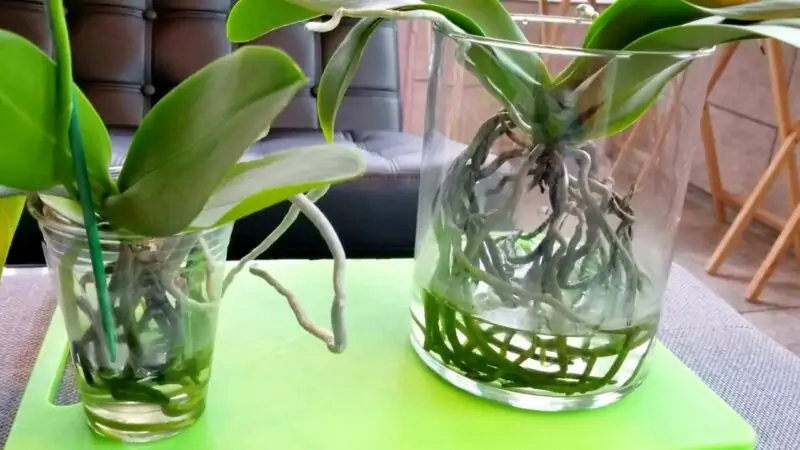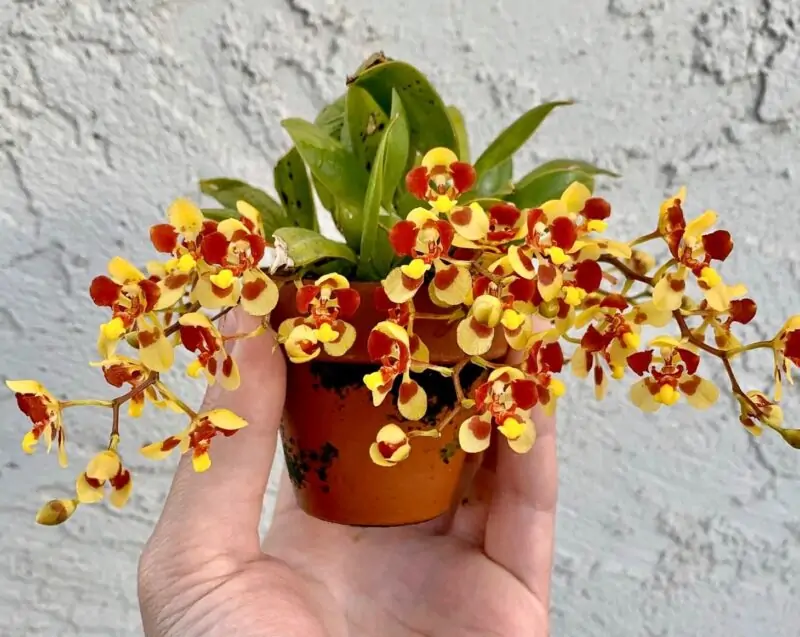Can Your Orchid Grow in Water: The Definitive Guide

Warning: Undefined property: stdClass::$error in /sites/makeoveridea.com/wp-content/themes/theissue/inc/misc.php on line 71
Warning: Undefined property: stdClass::$error in /sites/makeoveridea.com/wp-content/themes/theissue/inc/misc.php on line 71
Warning: Undefined property: stdClass::$error in /sites/makeoveridea.com/wp-content/themes/theissue/inc/misc.php on line 71
Can your orchid grow in water? Although this question might seem unusual, it’s an intriguing possibility for numerous gardeners. Growing orchids in water, also known as water culture, is an alternative method that has gained popularity among orchid growers. This article will explore the science behind this method and its benefits.
Can Orchids Really Be Grown Using Water?
Yes, they can! While it may seem counterintuitive, certain types of orchids can thrive in water culture. This method is prevalent for Phalaenopsis orchids, which are known to adapt well to growing in liquid. However, it’s essential to understand that not all orchids suit this method. The key to a thriving water culture is selecting the correct species of orchid and providing the proper growing environment.

The Science Behind Water Culture for Orchids
Plants called epiphytic (orchids are one of the better-known examples of epiphytic plants) naturally grow on tree branches and trunks rather than in soil. They have specialized aerial roots that absorb water and nutrients from their surroundings. You can submerge these roots in water, allowing the plant to take the necessary moisture and nutrients directly from the liquid. As some species of orchids can grow without soil, this method mimics their natural habitat and provides a moist environment without needing a traditional potting mix.
According to a study published in the Journal of the American Orchid Society, the Phalaenopsis orchid variety is grown using water had a higher root growth rate compared to those grown in a traditional bark-based medium. This finding supports the idea that liquid can be a viable method for growing specific orchids.
Understanding Water Culture for Orchids
This method of growing orchids presumes that the plant’s roots are partially or fully submerged in water. Orchid growers use liquid to provide their plants the moisture and nutrients without using traditional potting mixes. This method benefits those who struggle with overwatering or rotting roots, as the water culture method can help prevent these common issues.
What is Water Culture?
It is a method that involves placing the orchid’s roots in a container with a small amount of liquid. The water level should be just enough to cover the roots without submerging the entire plant. As the water evaporates, the orchid’s roots absorb moisture and nutrients directly from the liquid, creating a humid environment that mimics their natural habitat.
This method can be subdivided into full and semi-water cultures. Full water culture presumes that the orchid’s roots are fully submerged, while in semi-water culture, the roots are only partially submerged, with the liquid level kept below the roots.
The Benefits of Growing Orchids in Water
This approach has several benefits, especially for those who struggle with traditional growing methods. Some of the advantages include the following:
- Reduced risk of root rot: Overwatering is a common problem for plant growers, which leads to root rot and the eventual death of the plant. Water culture allows for better control of the moisture level, reducing the risk of overwatering and root rot. What’s more, it can be an ideal environment for the orchids of some varieties.
- Easier maintenance: This method requires less maintenance compared to traditional growing methods. You must only replace the water periodically and provide nutrients through a water-soluble orchid fertilizer.
- Enhanced growth: As mentioned earlier, research has shown that specific orchids can experience improved root growth when grown in liquid.
- Space-saving: This can be an excellent space-saving solution for those with limited room to grow their orchids. You can use smaller containers and even grow multiple orchids in a single container, depending on the size and species of orchids you have.
- Improved air circulation: This approach can promote better air circulation around the roots, which is essential for healthy root development and overall plant health.
- Easy observation: This method makes it easier to monitor the condition of the orchid’s roots and spot potential issues early on, as the roots are more visible than traditional growing methods.
However, it’s important to note that this culture may not be suitable for all orchid plants. Some species might not adapt well to this method, and it may take some experimentation to find the right balance of water and nutrients for each specific orchid.
The Different Types of Orchids and Water Culture
While this method works for many orchids types, some species are more suitable for this method than others. Understanding the different species of orchids and their compatibility with water culture is essential to ensure the best results.
Phalaenopsis Orchids: Ideal Candidates for Water Culture
Also known as moth orchids, they are one of the best candidates for hydroponic growing. These popular orchids are native to tropical regions and naturally grow on tree branches, where their aerial roots absorb moisture and nutrients from the air. Their adaptability to various growing conditions makes them an excellent choice for this growing method, especially for beginners.
Other Orchids Suitable for Water Culture

While the Phalaenopsis variety is the most popular choice for water culture, other orchid species can also be grown using this method. Some examples include:
- Oncidium Orchids: Known for their stunning flowers and long-lasting blooms, Oncidium orchids can adapt well to water culture. However, they might require a more controlled environment to prevent overwatering.
- Dendrobium Orchids: These orchids, known for their beautiful flowers and diverse growth habits, can also be grown using this approach. Still, like Oncidium orchids, they may need careful monitoring to ensure they don’t receive too much water.
- Paphiopedilum Orchids: Also known as slipper orchids, these unique and exotic plants can are suitable for this method, but it’s essential to maintain proper water levels and avoid overwatering.
Getting Started: How to Grow an Orchid in Water
While this growing method may seem daunting, with the proper knowledge and techniques, you can successfully master it.
Choosing the Right Orchid and Growing Medium
As discussed earlier, not all orchids are suitable for this approach. Start by selecting an orchid species that adapt well to this method, such as Phalaenopsis, Oncidium, or Dendrobium. Additionally, you’ll need a transparent container that allows you to monitor the level of liquid and the roots’ health.

Preparing Your Orchid for Water Culture
Follow these steps:
- Carefully transfer the orchid from its current pot and the medium used for growing.
- Take care of the root system: Trim away damaged, rotten, and/or noticeably old roots.
- Rinse the remaining roots with clean water to remove any debris or leftover growing medium.
- Choose a suitable container, ensuring you place your orchid into a new orchid pot that has enough space for roots to grow and proper drainage.
Water Quality and Orchid Health
The quality of the water you use to grow plants is crucial for the health and success of your orchid. Tap water often contains chemicals that can harm your orchid, so it’s best to use distilled water or rainwater. Make sure that the liquid level in the container is just enough to cover the roots without submerging the entire plant: orchids don’t grow well in excess water, and there should always be free access to oxygen to the root. Maintain the water level and replace the water in the container regularly, ideally, once a week, to maintain a clean and healthy growing environment.
By following these guidelines and paying close attention to your orchids’ needs, you can enjoy the beautiful blooms of your flowers for years to come.
Maintaining Your Plants in Water Culture
Proper maintenance is critical to ensuring your orchid thrives in liquid. This includes providing the right amount of water, changing the water regularly, and monitoring the growth of your orchid.
How Much Water Do Orchids Need?
The amount of water needed by orchids in water culture depends on the orchid species and the size of its roots. Generally, the liquid should cover the roots without submerging the entire plant. Keep a close eye on the lever of your liquid, and do not allow the water to cover too large a part of the root. Adjust the level to ensure the roots are not too wet or dry.
When to Change the Water and Monitor Growth
Changing the water in your orchid’s container is essential to maintain a clean and healthy environment. Replace your water once a week to prevent bacterial and fungal growth. Provide new water and fertilize your flower regularly and never forget to monitor how your plant grows, including developing new roots, leaves, and blooms. Adjust your maintenance routine accordingly if you notice any issues, such as yellowing leaves or root rot.
FAQs
Every orchid is different, and not all are suitable for this way of growing. Some species, like Phalaenopsis, Oncidium, and Dendrobium, can adapt well to this method, while others may not thrive in water. It’s essential to research each specific orchid type and consult with experienced orchid growers to determine if water culture is the proper method for your plant.
An orchid stem can survive in water for long periods of several weeks, depending on the orchid species and the conditions provided. However, water culture is typically more suitable for growing orchids long-term, as it allows the roots to absorb water and nutrients directly from the water.
Water from a tap often contains chemicals and minerals that can harm your orchid. It’s best to use distilled water or rainwater for orchid water culture, as these sources are free of potentially harmful substances.
Conclusion
Growing an orchid in water may seem daunting, but with the proper knowledge and care, it’s possible to grow these beautiful plants using water culture successfully. By understanding the needs of your specific orchid type and providing proper maintenance, you can enjoy the stunning blooms of your water-grown orchid for years to come. So, can orchids grow in water? The answer is yes, with the right approach and dedication to your plant’s needs.